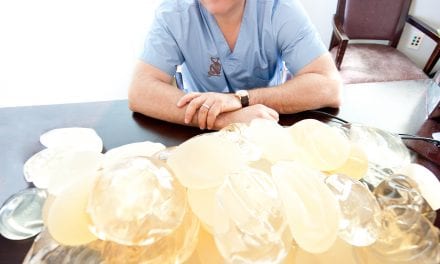A cohort of plastic surgeons across the United States is offering new, high-resolution ultrasound (HRUS) technology to help their patients more easily detect ruptured silicone gel implants and report on their experience.
Silicone breast implants may rupture without any symptoms, called a “silent rupture.” The FDA recommends that women with silicone gel breast implants receive MRI scans every two years for life in order to detect silent ruptures. However, MRIs are expensive and are usually not covered by health insurance plans, so compliance with this recommendation is low.
Now that several studies have documented the accuracy of in-office HRUS for detecting silent rupture of silicone gel implants, surgeons are looking to provide this new technology for their patients.
“With silicone gel implants, we’ve always said you have to do some sort of test to figure out if they’re ruptured,” states Dr Michael Zwicklbauer, a board-certified plastic surgeon at the Plastic Surgery Center of Hampton Roads in Virginia, in a media release from Ideal Implant.
“The FDA recommends doing MRIs, and as it turns out, less than 5% of people are doing that. And I get it. It can be difficult and time-consuming to make an appointment at an MRI center. Now I can say to women: ‘I’ve got a nurse here who can do an ultrasound of your breast to check the implants. You’ll be done in about half an hour, 45 minutes. Do you have the time?'”
The national study is being conducted in nine facilities across the country in order to evaluate how women feel about having the new HRUS scans of their silicone gel breast implants.
HRUS is being offered at no cost to the first 150 women in each facility who have silicone gel implants that were placed between 2000 and 2015. Women not eligible for the study who wish to check for implant rupture are offered the ultrasound option at a low cost.
Dr Michael Lofgren, a plastic surgeon partner of Dr Zwicklbauer, explains, “I tell all my patients when they’re considering implants, these are temporary devices. They will likely require some type of update in the future. I see my patients on a yearly basis after surgery and just check in with them, see how they’re doing. We talk about ongoing surveillance of the implants, and now with the ultrasound as an option, it can be conveniently done at that annual appointment.”
“The ultrasound is an incredibly powerful option for my patients, because in the back of their minds I think they’re always wondering about their implants,” Lofgren reports, the release continues. “And now we have an option that we can do easily and quickly in the office and give them some peace of mind. Patients have really been appreciative.”
Zwicklbauer shares, “Every patient of mine with silicone gel implants who qualifies for this study has embraced having the ultrasound. My message to any woman with silicone gel implants is to take a peek at what’s going on inside. You don’t want to go through an operation to find out that the implants are broken. You can do an MRI to find out if they’re broken, but MRIs are expensive. So let’s do an ultrasound.”
[Source: Ideal Implant]





